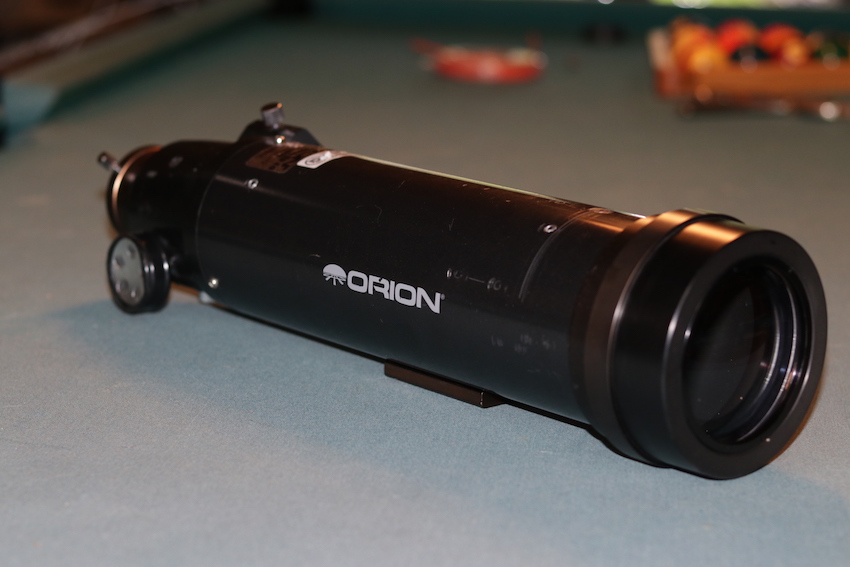Orion’s ED80 is not a premier new astrophotography telescope by any stretch of the imagination, but it has stood the test of time and in most cases, I find it to be a far superior instrument to the inexpensive 71/72mm fast ED refractors out there, both for visual and astrophotography use.
Overview Of Orion’s ED80
The ED80 uses a relatively simple apochromatic doublet design, with an FPL-53 lens element. This design is pretty much the gold standard for most inexpensive ED doublets. Pricier scopes will either use fluorite in place of the FPL-53, or add an additional lens element – either provide better color correction and the latter can improve edge-of-field aberration control, which is crucial for astrophotography. But the ED80’s design does just fine, and there’s not much chromatic aberration.

Many beginners pick smaller, faster ED doublets than the ED80 for astrophotography as well as visual use. I think this is a mistake. The ED80’s slower focal ratio of f/7.5 may not make it quite as suitable for wide-field views or imaging, but at the same time it has much sharper high-power images, doesn’t need super-short focal length eyepieces or a Barlow for high magnification use, and the reduced chromatic aberration means less bloat on your stars in images – additionally, the longer focal length allows you to do a little better imaging small objects like globular clusters and galaxies (though they’re still not ideal targets for a small refractor).
The ED80’s focuser is a relatively proletarian single-speed 2” Crayford. It works just fine for visual and imaging, there’s a tension adjustment screw, it’s all-metal and overall I think it’s adequate for imaging. The focuser also has a Vixen/Synta-style shoe molded-in for a finderscope/red dot sight to be attached.
The only critique I have of the scope itself is that the lens cell is not collimatable – not a huge concern, but annoying nonetheless. Some people suggest collimating it at the focuser but this can be risky for whatever gear you have attached to the focuser if you unscrew one of the three screws too far, and it’s more time-consuming.
Astrophotography
For deep-sky astrophotography with the ED80, you definitely need a field flattener. The one Orion sells is just fine. Orion also manufactures a 0.85x reducer/flattener specifically for the ED80 at a higher price, should you want to reduce the focal ratio.
On most EQ5 and EQ6-class mounts, you can get away with exposures between 30-60 seconds unguided with the ED80 and a DSLR. Guiding is of course necessary for longer exposures.
For guiding, I would recommend just taking advantage of the ED80’s built-in shoe and just putting a 30mm or 50mm guide scope in. A dual-scope style mounting plate and larger guide scope is overkill, and the hypothetical increase in guiding accuracy is probably going to be offset by the increased strain you’re putting on the mount, in addition to the high cost of obtaining said hardware.
With 600mm of focal length, the scope is best for wide-field imaging of nebulae and open clusters. However, you can get surprisingly good images of globular clusters as well as bright galaxies like M51 with the ED80, the latter provided you can get good integration time/signal-to-noise ratio to reduce noise as much as possible.
Mounting Options
The ED80 comes with a simple foot on the bottom with a ¼ 20 hole for use on a photo tripod, which is fine for birding or casual astronomy use. However, for almost anything else you’ll want to buy Orion’s 100mm ID tube rings and a compatible Vixen-style dovetail plate, which will allow you to put the ED80 on almost any mount you could possibly want.
For visual use, I would choose a lightweight alt-azimuth mount like the Vixen Porta II or Explore Scientific Twilight I. An equatorial mount is really only necessary for astrophotography with the ED80 and can easily double or triple the weight of the whole setup.
For astrophotography, you of course want a computerized German equatorial mount with autoguider compatibility. Orion sells this scope bundled with their Sirius HEQ5 and this is really the best choice all around (Sky-Watcher’s HEQ5 Pro is identical apart from the fit and finish). Celestron’s Advanced VX will work too if that’s all you can afford, but its tracking accuracy is inferior and you will rely more on autoguiding to pick up the slack, which kind of ruins the cost savings. I would recommend getting the Sirius and putting off autoguiding at first over buying an Advanced VX and guiding.
Conclusion
I would highly recommend the Orion ED80 to a beginner looking to get into astrophotography, or as a grab n’ go instrument for the experienced astronomer. It is a great scope and provides tremendous value if you don’t mind shopping around for accessories separately.
